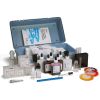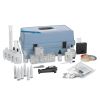Hach FF-3 Saltwater Aquaculture Test Kit
Features
- The digital titrator is a compact, accurate dispensing unit that replaces a buret
- Color disc features a continuous-gradient color wheel for fast, accurate comparisons
- All tests are stored in rugged carrying case
- Free ground shipping
- Expedited repair and warranty service
- Lifetime technical support
- More
Aquaculture has developed into a highly sophisticated field that uses scientific techniques to maintain the water where marine plants and animals live. The ability to optimize parameters affecting water quality is important for efficient production, and sensitive and accurate testing methods are essential.
The Hach saltwater aquaculture test kit is designed to meet this need. The kit includes chemicals and apparatus for the determination of 10 important water parameters and a rugged, armored thermometer for temperature readings. Packaged in a durable, portable case, the kit is well-suited for measurements in the field.
Acidity, alkalinity, carbon dioxide, dissolved oxygen, hardness, and salinity tests are conducted with the Digital Titrator - a compact, accurate dispensing unit that replaces a buret. Ammonia nitrogen, nitrite-nitrogen, and pH determinations are colorimetric tests. Results are obtained by matching the developed color of the sample to a pre-calibrated color disc.
With the Hach saltwater aquaculture test kit, the analyst can obtain the data necessary for making the right management decisions.
- (24) Reagents
- (1) Flask
- (1) Graduated Cylinder
- (1) Color Comparator Box
- (3) Color Discs
- (1) Vial
- (1) Delivery Tube
- (1) Syringe
- (2) Plastic Tubes
- (1) BOD Bottle
- (1) Thermometer
- (1) Digital Titrator
- (1) Manual
- (1) Carrying Case
In The News
Three Decades of Research at Acton Lake
A multi-disciplinary team at Miami University, Ohio, has been studying the environmental change at Acton Lake for over three decades. Using three different NexSens buoys over this time, the team has an incredible archive of data that is helping build a picture of Acton’s past, present, and future. Until recently, a NexSens CB-50 buoy was used alongside other environmental monitoring at Acton Lake. In May 2025, the Miami team deployed a new XB-200 buoy , future-proofing their ongoing monitoring using real-time buoy systems. Acton Lake, a small hypereutrophic reservoir in southwest Ohio, covers 2.4km² and has a maximum depth of about 8m. The dam was built in 1956, and the lake has a large agricultural watershed.
Read MoreSource Water Monitoring in Albany, New York: Tracing Water Quality throughout Tributaries
Thousands of US cities pull their drinking water from natural source waters like reservoirs, rivers, and streams, making overall watershed health a key consideration for water providers. In Albany, New York, the Albany Department of Water and Water Supply delivers drinking water to over 100,000 residents as well as monitors and manages the larger drinking water supply watershed. Hannah Doherty, Environmental Specialist at the Albany Department of Water and Water Supply , spends her days working with a small team to monitor the drinking supply and the connected water bodies. Doherty explains, “We’re the first to encounter the water that ends up being the drinking water.
Read MoreWildfire Prevention in the Sierra Nevada Region with the Yuba Watershed Institute
Though recent wildfires have sparked new conversations about wildfire management and response, groups like the Yuba Watershed Institute have been monitoring the forests and water resources of the Sierra Nevada region for decades, managing approximately 5,000 acres of land with the Bureau of Land Management (BLM) and about 7,000 acres in private land partnerships. The goal of the Institute is to work with local communities and land agencies to improve watershed and forestry management through informed practices and public outreach. The goals of the Yuba Watershed Institute are three-fold: Improve the ability of fire suppression agencies like the California Department of Forestry and Fire Protection ( CAL FIRE ) and the US Forest Service.
Read More








